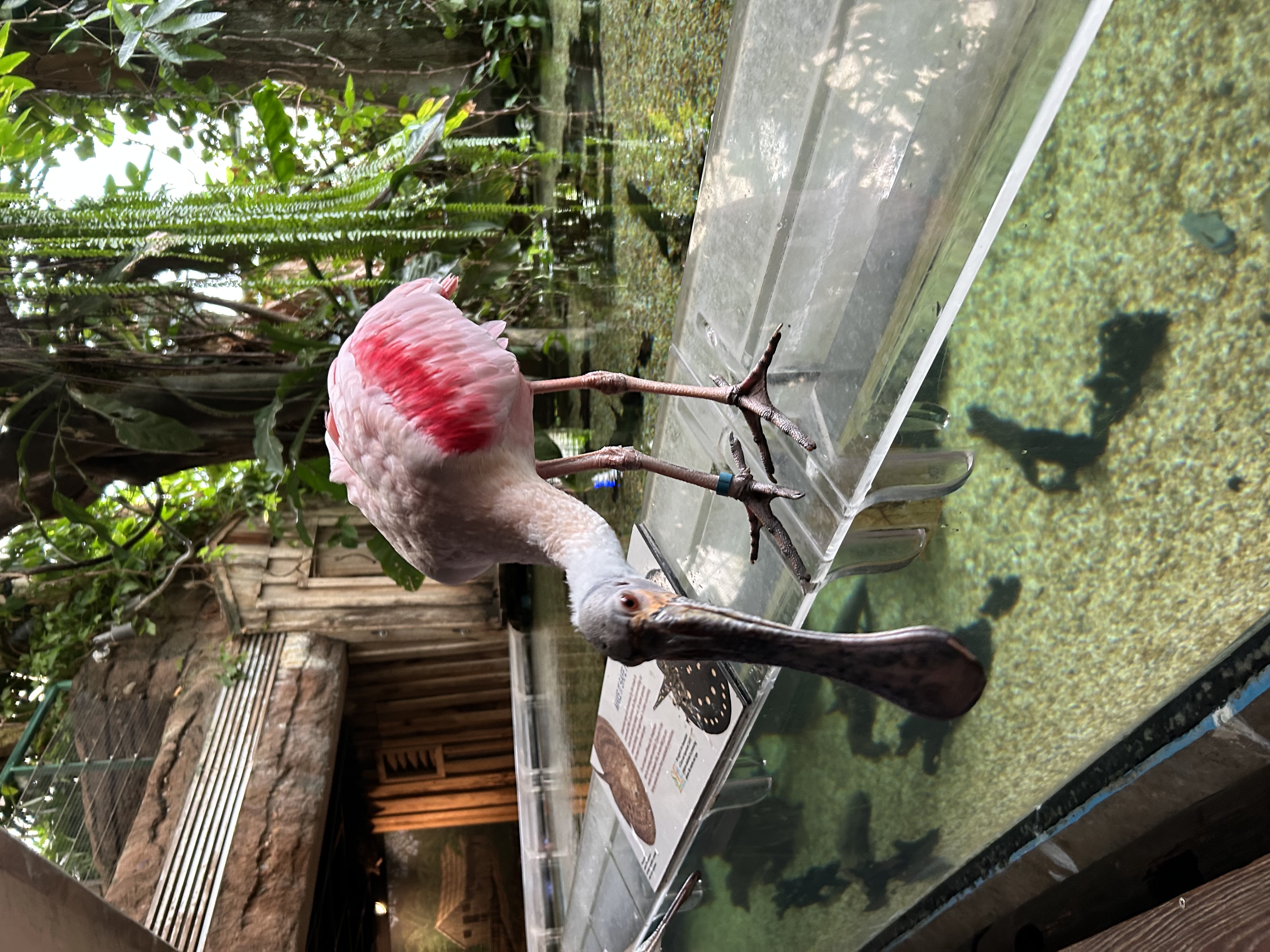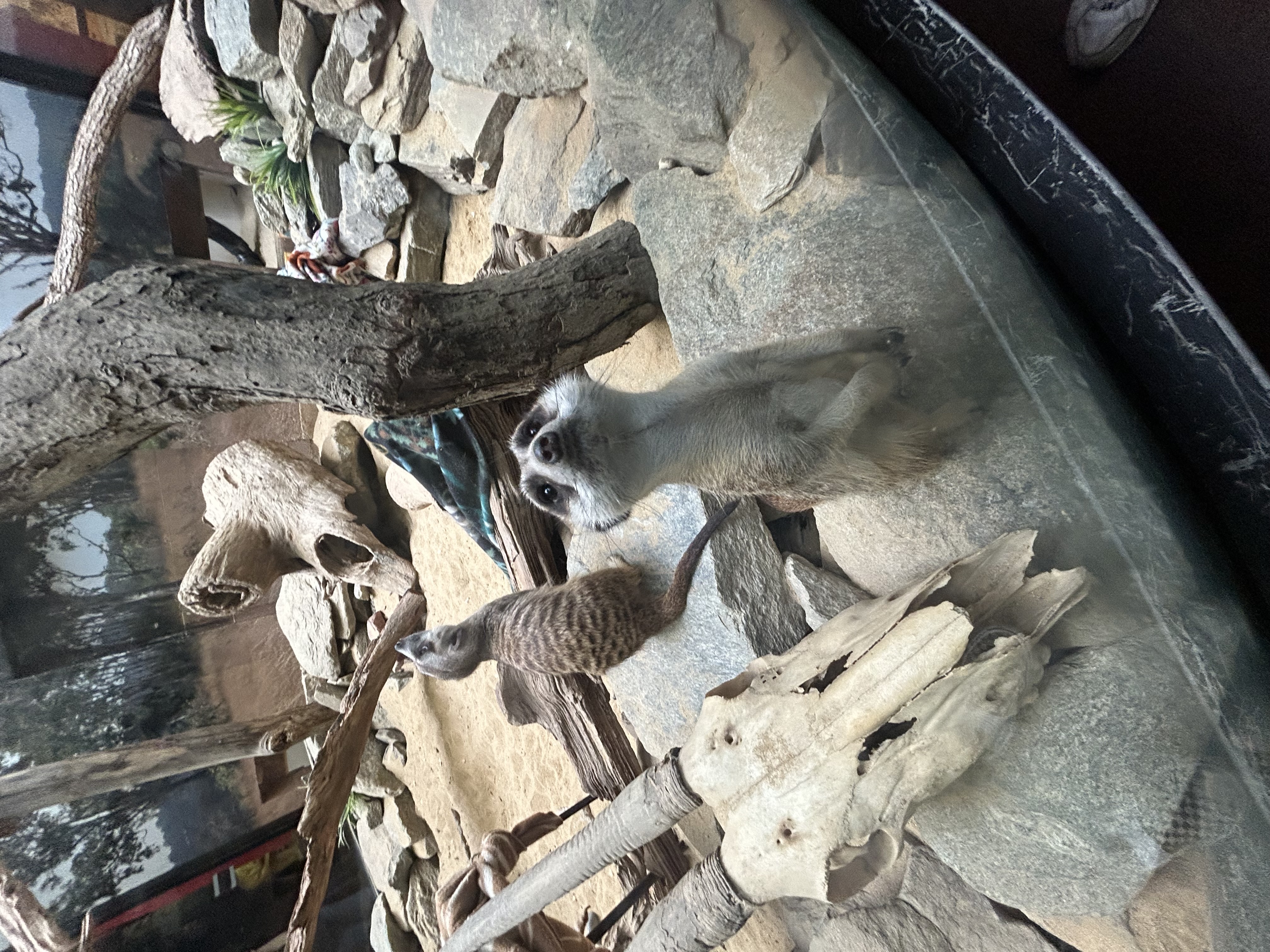Event name: Smithsonian National Zoo Excursion
Event time and place: May 4th, 2025 Washington D.C.
The morning of May 4th, 2025 brought with it a dreary rain and not a bit of sun in the sky. However, it also brought me a wonderful excursion to the Smithsonian National Zoological Park in DC. Located just off of Connecticut Avenue, the zoo is filled to the brim with animals from all over the world and plenty of opportunities to learn about them all. There are a multitude of animal houses throughout the park each with their own specializations, education techniques, and animal enclosures. Overall, the trip was a fun way to learn more about both common and endangered species from around the world and many of their behaviors and selected traits.

A Spoonbill Poses for the Camera
Firstly, my excursion brought me to the Small Mammal House. This animal house was filled with plenty of interesting warm blooded animals from around the world. Other than the many empty exhibits, there were plenty filled with animals such as the golden-headed lion tamarin, the prehensile-tailed porcupine, naked mole-rats, the dwarf mongoose, and meerkats. Each species had its own plaque next to its enclosure with a fun fact, its range, habitat, and diet. For example, from the plaque I learned that the prehensile tailed-porcupine will raise their quills and lunge at predators and they will turn sideways to look bigger and more formidable. They live in South America and are found in tropical forests. They eat leaves, flowers, shoots, and roots. Along with the plaques there were also a couple interactive multiple choice questions that you could try and answer according to an x-ray of a small mammal. They basically ask you to identify the animal with the help of an x-ray and you can lift a flap to see if you were right. This seemed semi-informative since I myself got a couple questions wrong, but it was just a fun activity. The hall seems suitable for all ages and anyone can find something to learn, but a lot of the information seems most complimentary for middle schoolers. Younger kids would need their parents to explain some of the concepts like habitat and diet while high schoolers and adults would probably be capable of understanding a little bit more about some of the species than what was listed. Most of the plaques were ignored by other visitors and families were more interested in just watching the animals.
One of the last parts of my excursion was actually in the Amazonia house with a tour from Dr. Merck. This was a house dedicated to featuring animals from the Amazon. However, this exhibit was more interactive and you could actually walk amongst some of the animals and plants rather than just looking at them through glass like in the Small Mammal House. This exhibit had species such as freshwater stingrays, roseate spoonbills, arapaima, a matamata turtle, and even guinea pigs. Most of the plaques for the species simply had a picture, their scientific name, and a couple facts in a short description of the animal. For example, the matamata turtle, or Chelus fimbriatus, has a description mentioning that although he does not have gills, they can lay underwater and use their nose as a sort of snorkel to breathe. Other than plaques, they had a couple things you could touch to have a little more interactivity in the exhibit. For example, they had an electric eel statue that you could touch from both ends to represent the electric current the eel can generate. They also had a coral skeleton at the end of the hall that you could touch. All these things along with their descriptions seem to help try and teach you something about the organism, whether it was about a special function or just how something actually feels and why it feels that way. The hall seemed to be aimed at young elementary school audiences since the plaques weren’t very noticeable and the descriptions on those plaques were very kid friendly at that. Much like the Small Mammal House, the Amazonia house had very few visitors actually reading the plaques. It was mostly people just walking around and taking pictures of the animals. Every once in a while though, a parent would read an animal's plaque to explain what a certain animal was to their kid.
The zoo was also filled to the brim with information on animals and ecosystems. And a lot of it was presented as actual interactive material found in different areas. For example, one of my favorite houses that I went in was the Think Tank. This house was filled with all sorts of information about animal brains and the use of tools over time. One of the coolest parts about this house was the replicas of all the brains they had. You could see and feel the different shapes and sizes of different animal brains. They also had all kinds of examples of tools used by animals, such as sticks used for termite fishing and a model termite mound. All of these exhibits had plenty of printed information, but they were getting visitors to visually understand how different animals think and how fascinating some of their natural behaviors really can be. Another really cool thing they had were representatives from the Amphibian Research and Monitoring Initiative. These people had plenty of information to share on different kinds of amphibians found in the world and were happy to answer my questions about habitat loss on amphibians. They were there for national amphibian week and just wanted to educate those who stopped by a little bit about the kinds of amphibians in the world. They were also handing out plenty of frog stickers.

A Meerkat Looks up at Visitors
The last thing I want to mention is how the zoo tries its best to help with animals’ mental and emotional wellbeing. The first thing I noticed on this subject was all of the objects and toys in the orangutan enclosure. One orangutan had a bucket filled with bubbles that they were just constantly playing with. They honestly looked really fascinated with the bubbles and were happily trying to eat them. There was also another orangutan who was playing with some fabrics in their enclosure by rolling up in them and trying to scare another orangutan. Another way the zoo helps with animal mental wellbeing is by giving animals dedicated private spaces. Many of the enclosures have rooms or areas that the public can’t actually view, but the animals are free to move back and forth from. This was especially true for the meerkats who had a big room behind their front enclosure. These spaces give the animal room to breathe and not have to constantly entertain humans.
Overall, the zoo was a fun trip to go on with Science and Global Change. I hadn’t been in a long time and with it being so close and easy to get to, I’m surprised I hadn’t gone already. After being there again after a long time, I really understood how well it’s put together and how much it really tries to encourage learning about and interacting with animals and our environment. And to think that all of this is completely free. All of the plaques you can read, all the animals you can see, all the zookeeper's you can talk to and learn from. All of this is free. The Smithsonian National Zoological Park is truly an icon of Washington DC and everyone should get to experience it.


